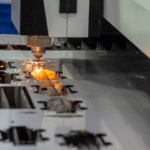Choosing an appropriate Ethernet cable can have a significant impact on the performance of your network. As you install a home network or wire a busy office, the cable you install determines the speed, stability, and scalability in the future.
The three most popular Ethernet cables are Cat5e, Cat6 and Cat6a. They may appear to be the same but on closer examination, their abilities are different. Learning the functionality of each of the types will assist you in making an intelligent, future-proof decision on which one to use in your network.
Understanding Cat5e Cables
The Cat5e or Category 5 Enhanced is one of the most popular Ethernet cables to use at home and small offices. Its maximum speed is up to 1 Gigabit per second with 350 MHz bandwidth .
Based on what I have observed in the smaller network configurations, Cat5e can still be used reliably in simple internet access, video streaming and light file transfers. It is also cheap and simple to install. Nevertheless, it does not suit heavy traffic, high-performance business networks or settings where you require 10 Gigabit Ethernet.
Cat5e is also capable of handling the job, when you have simple network requirements and do not have major upgrades planned in the near future. However it can be a limiting factor in future growth.
Understanding Cat6 Cables
Cat6 Ethernet cable is the natural step up from Cat5e. It supports 1 Gigabit Ethernet up to 100 meters and 10 Gigabit Ethernet up to 50 meters. Its 550 MHz frequency enables transmission of data faster and it is more resistant to interference due to introduction of spline which minimizes crosstalk among twisted pairs.
Cat6 is a perfect fit in small to medium size offices or homes that have numerous devices streaming, playing games, and working at the same time. It is also a good choice for users who intend to install Power over Ethernet (PoE) devices such as cameras and VoIP phones.
The performance and reliability gains justify the expense, which is a bit higher than that of Cat5e.
Understanding Cat6a Cables
Cat6a or Category 6 Augmented Ethernet Cable is designed to support high-performance and future networks. It supports 10 Gigabit Ethernet up to 100 meters with a frequency range of 750 MHz providing excellent data integrity and minimal interference.
During the course of commercial installations I have been involved in, Cat6a was always found to be the most stable option when it comes to heavy data transfers, cloud applications, and 4K video conferencing. Cat6a provides the stability and speed your network requires, especially when your office depends on heavy data transfers, cloud applications and video conferencing in 4K.
It is also the best choice for networks that must remain reliable for the next 10 years or more, as it can handle emerging technologies without requiring frequent upgrades.
Key Differences Between Cat5e, Cat6, and Cat6a
Here’s a quick comparison to help you choose the right cable for your needs:
Maximum Speed: Cat5e supports 1 Gbps; Cat6 supports 1 to 10 Gbps; Cat6a supports 10 Gbps at full length.
Frequency: Cat5e up to 350 MHz, Cat6 up to 550 MHz, Cat6a up to 750 MHz.
Distance for 10 Gigabit Ethernet: Cat5e cannot support it, Cat6 up to 50m, Cat6a up to 100m.
Interference Resistance: Cat6 and Cat6a have better shielding and reduced crosstalk compared to Cat5e.
Best Use Case: Cat5e for basic home use, Cat6 for busy homes or small offices, Cat6a for high-performance and future-proof networks.
This comparison makes it easy to match cable performance with your current and future network demands.
Choosing the Right Cable for Your Network
The right choice depends on both your current needs and long-term plans. Cat5e is dependable and affordable in cases where you only use it to browse, stream, and do some light office work.
Cat6 is a viable compromise between Cat5e and Cat6a ethernet cables. It is commonly used in environments such as offices or home networks with multiple users as you can enjoy faster speeds and still have the ability to expand moderately.
In case of business or technology-intensive settings, Cat6a is the obvious choice. It is the most future-proof Ethernet cable, and can support increasing data demands, PoE devices, and 10 Gigabit throughout your network.
Planning for the Future
Although your existing devices may not need the fastest speeds, you can still save the future time and money by investing in cables of higher categories now. According to customer reviews, the replacement of cables hidden in the walls or the ceiling is always more disruptive and more expensive than the selection of the correct category at the very beginning. When initially setting up, it is important to choose Cat6a so that you can have a network that is ready to accommodate new technologies without having to rewire the network regularly.
Organized structured cabling also improves reliability and future upgrades by using essential accessories like patch panels, keystone jacks, RJ45 connectors, and wall plates..
Conclusion
The type of Ethernet cable you use will have a direct impact on the speed, reliability and future scalability of the network. Cat5e is cost-effective when the requirements are basic, Cat6 is a powerful option to expand networks, and Cat6a suits business or any user who wishes to be prepared for the next ten years of technology.
By understanding these differences, you will be able to select a cable that will not only address your current requirements but also maintain your network running in a smooth manner as the technology changes.


